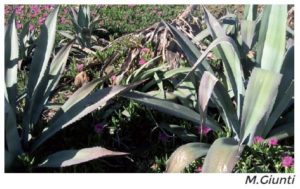 Common name: Agave
Common name: Agave
Scientific name: Agave americana
Brief description: The plant is formed of succulent leaves, arranged in a rosette, with a long shape, which reach 2m in length and are around 20cm wide, terminating in a spike. Its bloom is very characteristic, occurring only once for each plant, when it reaches maturity (around 20-30 years). The flower, yellow in colour, emerges from the centre of the plant, reaching a height of up to 9 metres. After flowering, the mother plant dries up, but at the same time it survives thanks to the stolons (lateral branches) that form before flowering.
Biology and ecology: This species mainly invades rock faces and coastal cliffs, dunes, arid and rocky soils. It lives for a long time and reproduces thanks to its abundant stolons. In this way a single individual can form a very dense population.
Distribution in the Tuscan Archipelago and introduction: The exact origin of this species is uncertain and there are many sub-species and varieties. Agave americana spp. protoamericana, the supposed ancestor, grows in the tropical forests of Mexico. It was introduced in Italy in the 1500s for ornamental purposes or more rarely commercial purposes (in the past it was cultivated for the production of textile fibres). Agave americana is present on all the islands of the Tuscan Archipelago.
Impact: In southern Europe, in the islands of the Mediterranean and in southern Africa this species is invasive, as it expands uncontrollably in environments with fragile equilibria such as coastal ecosystems, resulting in considerable impacts on species and habitats of conservation value.
Management in protected areas: Individual experiments have been carried out on the Island of Capraia using systemic herbicides with not yet satisfactory outcomes.




